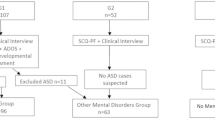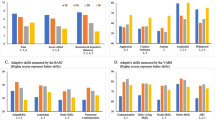Abstract
Diagnosing Autism Spectrum Disorders (ASD) is important throughout the lifespan. The objective was to investigate the transcultural diagnostic validity of the Social Communication Questionnaire (SCQ) in a clinical sample of 451 adults with Intellectual Developmental Disorder (IDD) with and without ASD in Germany, the U.S.A. and Great Britain. Variables associated with higher SCQ sum-scores were higher levels of IDD, male gender, a diagnosis of ASD and the study site (Germany > U.S.A > G.B.). An ROC analysis revealed a cut-score of 13, which resulted in a sensitivity of 0.87 and a specificity of 0.58. It is recommended to adjust the cut-score according to level of IDD and gender. Further research is needed to align diagnostic assignment of ASD across different sites and countries.

Similar content being viewed by others
References
Andrews, G., Pine, D., Hobbs, M., et al. (2009). Neurodevelopmental disorders: Cluster 2 of the proposed meta-structure for DSM-V and ICD-11. Psychological Medicine, 39, 2013–2023.
Bergmann, T., Sappok, T., Diefenbacher, A., et al. (2015). Music-based Autism Diagnostics (MUSAD)–A newly developed diagnostic measure for adults with intellectual developmental disabilities suspected of autism. Research in Developmental Disabilities, 43, 123–135.
Berument, S. K., Rutter, M., Lord, C., et al. (1999). Autism screening questionnaire: Diagnostic validity. The British Journal of Psychiatry 175, 444–451.
Bhaumik, S., Tyrer, F., Barrett, M., et al. (2010). The relationship between carers’ report of autistic traits and clinical diagnoses of autism spectrum disorders in adults with intellectual disability. Research in Developmental Disabilities, 31, 705–712.
Bölte, S., Holtmann, M., & Poustka, F. (2008a). The Social Communication Questionnaire (SCQ) as a screener for autism spectrum disorders: Additional evidence and cross-cultural validity. Journal of the American Academy of Child and Adolescent Psychiatry, 47, 719–720.
Bölte, S., Poustka, F., & Constantino, J. N. (2008b). Assessing autistic traits: Cross-cultural validation of the social responsiveness scale (SRS). Autism Research, 1(6), 354–363.
Bölte, S., Poustka, F., & Rutter, M. (2006). Fragebogen zur sozialen Kommunikation-Autismus Screening: Huber.
Bouras, N., Cowley, A., Holt, G., et al (2003). Referral trends of people with intellectual disabilities and psychiatric disorders. Journal of Intellectual Disability Research, 47, 439–446.
Brooks, W. T., & Benson, B. A. (2013). The validity of the social communication questionnaire in adults with intellectual disability. Research in Autism Spectrum Disorders, 7, 247–255.
Bryson, S. E., Bradley, E. A., Thompson, A., et al. (2008). Prevalence of autism among adolescents with intellectual disabilities. Canadian Journal of Psychiatry. Revue Canadienne de Psychiatrie, 53, 449–459.
Chaplin, E., Kennedy, L., Hammond, R., et al. (2006). Working Paper V. Clinical Management of Mental Health in Learning Disability (MHiLD) Services London.
Chaplin, E., Paschos, D., & O’Hara, J. (2010). The specialist mental health model and other services in a changing environment. In: Bouras, N., & Holt, G. (eds) Mental health services for adults with intellectual disability. Strategies and solutions. Hove: Psychology Press, 9–22.
Chestnut, S. R., Wei, T., Barnard-Brak, L., & Richman, D. M. (2016). A meta-analysis of the social communication questionnnaire: Screening for autism spectrum disorder. Autism: The International Journal of Research and Practice. doi:10.1177/1362361316660065.
Cicchetti, D. V., Volkmar, F., Klin, A., & Showalter, D. (1995). Diagnosing autism using ICD-10 criteria: A comparison of neural networks and standard multivariate procedures. Child Neuropsychology, 1, 26–37.
de Bildt, A., Sytema, S., Ketelaars, C., et al. (2003). Measuring Pervasive Developmental Disorders in Children and Adolescents with Mental Retardation: A Comparison of Two Screening Instruments Used in a Study of the Total Mentally Retarded Population from a Designated Area. Journal of Autism and Developmental Disorders, 33, 595–605.
de Bildt, A., Sytema, S., Ketelaars, C., et al. (2004). Interrelationship between Autism Diagnostic Observation Schedule-Generic (ADOS-G), Autism Diagnostic Interview-Revised (ADI-R), and the Diagnostic and Statistical Manual of Mental Disorders (DSM-IV-TR) classification in children and adolescents with mental retardation. Journal of Autism and Developmental Disorders, 34, 129–137.
Eaves, L. C., Wingert, H., & Ho, H. H. (2006). Screening for autism agreement with diagnosis. Autism: The International Journal of Research and Practice, 10, 229–242.
Filipeck, P. A., Accardo, P. J., Baranek, G. T., et al. (1999). The screening and diagnosis of autistic spectrum disorders. Journal of Autism and Developmental Disorders, 29, 439–484.
Fombonne, E. (2009). Epidemiology of pervasive developmental disorders. Pediatric Research, 65, 591–598.
Hall, S. S., Lightbody, A. A., Hirt, M., et al. (2010). Autism in fragile X syndrome: A category mistake? Journal of the American Academy of Child & Adolescent Psychiatry, 49, 921–933.
Hare, D. J., Chapman, M., Fraser, J., et al. (2003). The prevalence of autistic spectrum disorders in people using a community learning disabilities service. Journal of Learning Disabilities, 7, 267–281.
Harrison, P. L., & Oakland, T. (2003). Adaptive behavior assessment system, 2nd Edn. San Antonio, TX: Harcourt Assessment.
Holmes, N., Shah, A., & Wing, L. (1982). The disability assessment schedule: A brief screening device for use with the mentally retarded. Psychological Medicine, 12, 879–890.
Howlin, P., & Asgharian, A. (1999). The diagnosis of autism and Asperger syndrome: Findings from a survey of 770 families. Developmental Medicine & Child Neurology, 41, 834–839.
Kirkovski, M., Enticott, P. G., & Fitzgerald, P. B. (2013). A review of the role of female gender in autism spectrum disorders. Journal of Autism and Developmental Disorders, 43, 2584–2603.
Kraijer, D., & Bildt, A. (2005). The PDD-MRS: An Instrument for Identification of Autism Spectrum Disorders in Persons with Mental Retardation. Journal of Autism and Developmental Disorders, 35, 499–513.
Krug, D., Arick, J., & Almond, P. (1980). Behavior checklist for identifying severely handicapped individuals with high levels of autistic behavior. Journal of Child Psychology and Psychiatry, 2(3), 221–229.
La Malfa, G., Lassi, S., Bertelli, M., et al. (2004). Autism and intellectual disability: A study of prevalence on a sample of the Italian population. Journal of Intellectual Disability Research, 48, 262–267.
La Malfa, G., Lassi, S., Salvini, R., et al. (2007). The relationship between autism and psychiatric disorders in intellectually disabled adults. Research in Autism Spectrum Disorders, 1, 218–228.
Levy, S. E., Mandell, D. S., & Schultz, R. T. (2009). Autism. Lancet, 374, 1627–1638.
Lord, C. E. (2010). Autism: From research to practice. American Psychologist, 65, 815.
Lunsky, Y., Gracey, C., & Bradley, E. (2009). Adults with autism spectrum disorders using psychiatric hospitals in Ontario: Clinical profile and service needs. Research in Autism Spectrum Disorders, 3, 1006–1013.
Marshburn, E. C., & Aman, M. G. (1992). Factor validity and norms for the aberrant behavior checklist in a community sample of children with mental retardation. Journal of Autism and Developmental Disorders, 22, 357–373.
Matson, J., Boisjoli, J., Gonzalez, M., et al. (2007a). Norms and cut off scores for the autism spectrum disorders diagnosis for adults (ASD-DA) with intellectual disability. Research in Autism Spectrum Disorders, 1, 330–338.
Matson, J. L. (2016). Handbook of assessment and diagnosis of autism spectrum disorder. Cham: Springer.
Matson, J. L., Nebel-Schwalm, M., & Matson, M. L. (2007b). A review of methodological issues in the differential diagnosis of autism spectrum disorders in children. Research in Autism Spectrum Disorders 1, 38–54.
Matson, J. L., & Shoemaker, M. (2009). Intellectual disability and its relationship to autism spectrum disorders. Research in Developmental Disabilities, 30, 1107–1114.
Medical Research Council. (2001). MRC review of autism research. epidemiology and causes. London: Medical Research Council.
Meins, W., & Süssmann, D. (1993). Evaluation of an adaptive behaviour classification for mentally retarded adults. Social Psychiatry and Psychiatric Epidemiology, 28, 201–205.
Melville, C. A., Cooper, S.-A., Morrison, J., et al. (2008). The prevalence and incidence of mental ill-health in adults with autism and intellectual disabilities. Journal of Autism and Developmental Disorders, 38, 1676–1688.
Morgan, C. N., Roy, M., & Chance, P. (2003). Psychiatric comorbidity and medication use in autism: A community survey. The Psychiatrist, 27, 378–381.
Murphy, D. G., Beecham, J., Craig, M., et al. (2011). Autism in adults. New biologicial findings and their translational implications to the cost of clinical services. Brain Research, 1380, 22–33.
National Audit Office. (2009a). Supporting people with autism through adulthood. Model to assess the financial impacts of providing multi-disciplinary support services for adults with high-functioning autism/Asperger syndrome. Technical Paper. London.
National Audit Office. (2009b). Supporting people with autism through adulthood. Report by the Comptroller and Auditor General. HC 556 Session 2008–2009. London.
NICE. (2011a). Autism: Recognition, referral and diagnosis of children and young people on the autism spectrum. London: RCOG Press.
NICE. (2011b). Autism: Recognition, referral and diagnosis of children and young people on the autism spectrum. London: RCOG Press.
NICE. (2012a). Autism in adults: Diagnosis and management. Clinical Guidelines 142. London: The British Psychological Society.
NICE. (2012b). Autism: Recognition, referral, diagnosis and management of adults on the autism spectrum. London: The British Psychological Society.
Norris, M., & Lecavalier, L. (2010). Screening Accuracy of Level 2 Autism Spectrum Disorder Rating Scales A Review of Selected Instruments. Autism: The International Journal of Research and Practice, 14, 263–284.
Oosterling, I., Rommelse, N., De Jonge, M., et al. (2010). How useful is the Social Communication Questionnaire in toddlers at risk of autism spectrum disorder? Journal of Child Psychology and Psychiatry, 51, 1260–1268.
Ozonoff, S., Iosif, A.-M., Baguio, F., et al. (2010). A Prospective Study of the Emergence of Early Behavioral Signs of Autism. Journal of the American Academy of Child and Adolescent Psychiatry, 49, 256–266.e252.
Rutter, M., Bailey, A., & Lord, C. (2003). The social communication questionnaire: Manual. Los Angeles: Western Psychological Services.
Saemundsen, E., Juliusson, H., Hjaltested, S., et al. (2010). Prevalence of autism in an urban population of adults with severe intellectual disabilities–a preliminary study. Journal of Intellectual Disability Research, 54, 727–735.
Sappok, T., Bergmann, T., Kaiser, H., et al. (2010). Autismus bei erwachsenen Menschen mit geistiger Behinderung. Der Nervenarzt, 81, 1333–1345.
Sappok, T., Diefenbacher, A., Gaul, I., et al. (2015a). Validity of the Social Communication Questionnaire in Adults With Intellectual Disabilities and Suspected Autism Spectrum Disorder. American Journal on Intellectual and Developmental Disabilities, 120, 203–214.
Sappok, T., Gaul, I., Bergmann, T., et al. (2015b). Der diagnostische Beobachtungsbogen für Autismus Spektrumstörungen – Revidiert (DiBAS-R). Ein Screening-Instrument für Erwachsene mit Intelligenzminderung und Autismusverdacht. Bern: Verlag Hans-Huber.
Sappok, T., Heinrich, M., & Diefenbacher, A. (2014). [Psychometric properties of the Autism-Checklist (ACL) in adults with intellectual disability]. Psychiatrische Praxis, 41, 37–44.
Sappok, T., Heinrich, M., & Underwood, L. (2015c). Screening tools for autism spectrum disorders. Advances in Autism, 1, 12–29.
Stoesz, B., Montgomery, J., Smart, S., et al. (2011). Review of Five Instruments for the Assessment of Asperger’s Disorder in Adults. The Clinical Neuropsychologist, 25, 376–401.
Tsakanikos, E., Costello, H., Holt, G., et al. (2006). Psychopathology in adults with autism and intellectual disability. Journal of Autism and Developmental Disorders, 36, 1123–1129.
Underwood, L., Chaplin, E, & McCarthy, J. (2014). Screening for autism spectrum disorders in specialist mental health and forensic settings. IASSID 2014, Vienna.
Underwood, L., McCarthy J, Craig, T. (2016). Autism spectrum disorder among specialist mental health service users with intellectual disability. Research in Developmental Disorders.
Underwood, L., McCarthy, J., Tsakanikos, E., et al. (2012). Health and social functioning of adults with intellectual disability and autism. Journal of Policy and Practice in Intellectual Disabilities, 9, 147–150.
World Health Organization. (1992). The ICD-10 classification of mental and behavioural disorders: Clinical descriptions and diagnostic guidelines. Geneva: World Health Organization.
Acknowledgements
The funding was provided by von Bodelschwinghsche Stiftung Bethel.
Author Contributions
TS, WB and LU collected the data. All authors contributed in data analysis and interpretation and writing of the manuscript. All authors read and approved the final manuscript.
Author information
Authors and Affiliations
Corresponding author
Rights and permissions
About this article
Cite this article
Sappok, T., Brooks, W., Heinrich, M. et al. Cross-Cultural Validity of the Social Communication Questionnaire for Adults with Intellectual Developmental Disorder. J Autism Dev Disord 47, 393–404 (2017). https://doi.org/10.1007/s10803-016-2967-2
Published:
Issue Date:
DOI: https://doi.org/10.1007/s10803-016-2967-2




